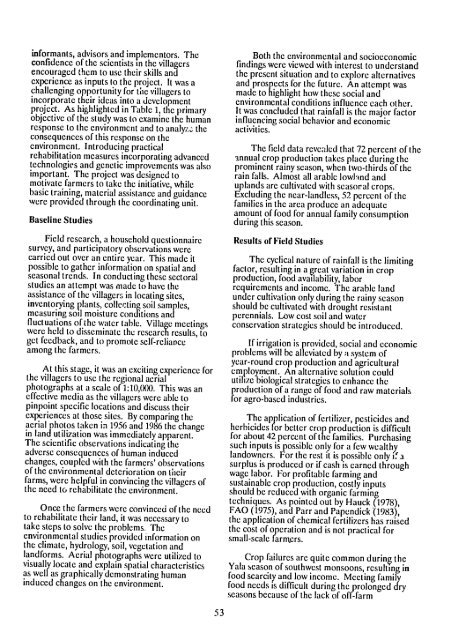multipurpose tree species research for small farms: strategies ... - part
multipurpose tree species research for small farms: strategies ... - part
multipurpose tree species research for small farms: strategies ... - part
You also want an ePaper? Increase the reach of your titles
YUMPU automatically turns print PDFs into web optimized ePapers that Google loves.
in<strong>for</strong>mants, advisors and implementors. The<br />
confidence of the scientists in the villagers<br />
encouraged them to use their skills and<br />
experience as inputs to the project. It was a<br />
challenging opportunity <strong>for</strong> the villagers to<br />
incorporate their ideas into a development<br />
project. As highlighted in Table 1, the primary<br />
objective of the study was to examine the human<br />
response to the environment and to analyz. the<br />
consequences of this response on the<br />
environment. Introducing practical<br />
rehabilitation measures incorporating advanced<br />
technologies and genetic improvements was also<br />
important. The project was designed to<br />
motivate farmers to take the initiative, while<br />
basic training, material assistance and guidance<br />
were provided through the coordinating unit.<br />
Baseline Studies<br />
Field <strong>research</strong>, a household questionnaire<br />
survey, and <strong>part</strong>icipatory observations were<br />
carried out over an entire year. This made it<br />
possible to gather in<strong>for</strong>mation on spatial and<br />
seasonal trends. In conducting these sectoral<br />
studies an attempt was made to have the<br />
assistance of the villagers in locating sites,<br />
inventorying plants, collecting soil samples,<br />
measuring soil moisture conditions and<br />
fluctuations of the water table. Village meetings<br />
were held to disseminate the <strong>research</strong> results, to<br />
get feedback, and to promote self-reliance<br />
among the farmers.<br />
At this stage, it was an exciting experience <strong>for</strong><br />
the villagers to use the regional aerial<br />
photographs at a scale of 1:10,000. This was an<br />
effective media as the villagers were able to<br />
pinpoint specific locations and discuss their<br />
experiences at those sites. By comparing the<br />
aerial hotos taken in 1956 and 1986 the change<br />
in landutilization was immediately apparent.<br />
The scientific observations indicating the<br />
adverse consequences of human induced<br />
changes, coupled with the farmers' observations<br />
of the environmental deterioration on their<br />
<strong>farms</strong>, were helpful in convincing the villagers of<br />
the need to rehabilitate the environment,<br />
Once the farmers were convinced of the need<br />
to rehabilitate their land, it was necessary to<br />
take steps to solve the problems. The<br />
environmental studies provided in<strong>for</strong>mation on<br />
the climate, hydrology, soil, vegetation and<br />
land<strong>for</strong>ms. Aerial photographs were utilized to<br />
visually locate and explain spatial characteristics<br />
as wel as graphically demonstrating human<br />
induced changes on the environment,<br />
53<br />
Both the environmental and socioeconomic<br />
findings were viewed with interest to understand<br />
the present situation and to explore alternatives<br />
and prospects <strong>for</strong> the future. An attempt was<br />
made to highlight how these social and<br />
environmental conditions influence each other.<br />
It was concluded that rainfall is the major factor<br />
influencing social behavior and economic<br />
activities.<br />
The field data revealed that 72 percent of the<br />
annual crop production takes place during the<br />
prominent rainy season, when two-thirds of the<br />
rain falls. Almost all arable low]-ind and<br />
uplands are cultivated with seasoral crops.<br />
Excluding the near-landless, 52 percent of the<br />
families in the area produce an adequate<br />
amount of food <strong>for</strong> annual family consumption<br />
during this season.<br />
Results of Field Studies<br />
The cyclical nature of rainfall is the limiting<br />
factor, resulting in a great variation in crop<br />
production, food availability, labor<br />
requirements and income. The arable land<br />
under cultivation only during the rainy season<br />
should be cultivated with drought resistant<br />
perennials. Low cost soil and water<br />
conservation <strong>strategies</strong> should be introduced.<br />
If irrigation is provided, social and economic<br />
problems will be alleviated by a system of<br />
year-round crop production and agricultural<br />
employment. An alternative solution could<br />
utilize biological <strong>strategies</strong> to enhance the<br />
production of a range of food and raw materials<br />
<strong>for</strong> agro-based industries.<br />
The application of fertilizer, pesticides and<br />
herbicides <strong>for</strong> better crop production is difficult<br />
<strong>for</strong> about 42 percent of the families. Purchasing<br />
such inputs is possible only <strong>for</strong> a few wealthy<br />
landowners. For the rest it is possible only iVa<br />
surplus is produced or if cash-is earned through<br />
wage labor. For profitable farming and<br />
sustainable crop production, costly inputs<br />
should be reduced with organic farming<br />
techniques. As pointed out by Hauck (1978),<br />
FAO (1975), and Parr and Papendick (1983),<br />
the application of chemical fertilizers has raised<br />
the cost of operation and is not practical <strong>for</strong><br />
<strong>small</strong>-scale farnwrs.<br />
Crop failures are quite common during the<br />
Yala season of southwest monsoons, resulting in<br />
food scarcity and low income. Meeting family<br />
food needs is difficult during the prolonged dry<br />
seasons because of the lack of off-farm

















